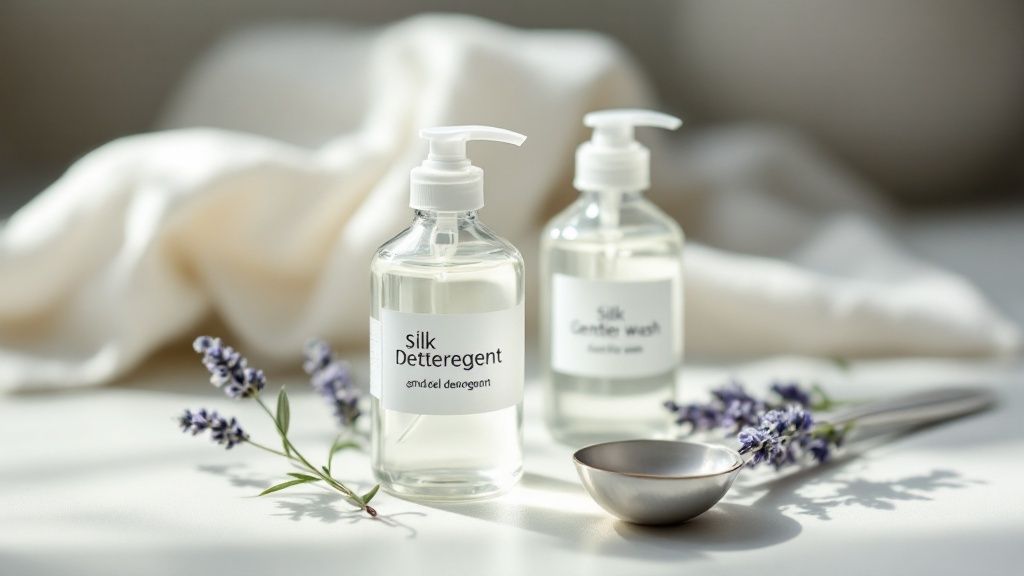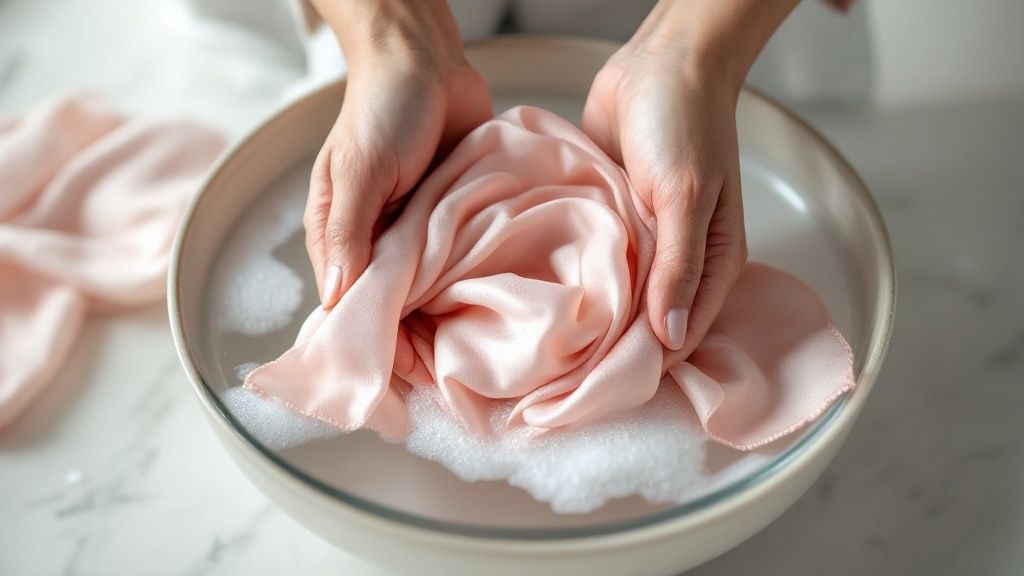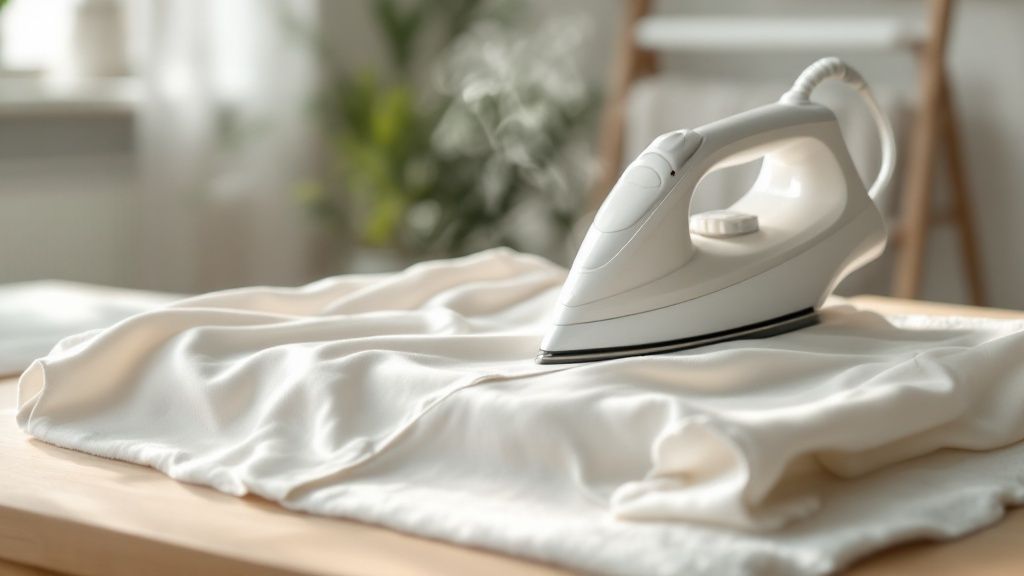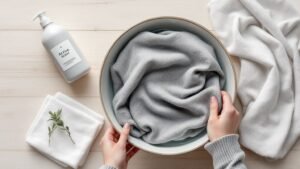
BEST LUXURY LAUNDRY DETERGENT – LONG LASTING SCENTS – (Free Shipping on Orders Over $49)
How to Hand Wash Silk to Keep It Perfect
Hand washing silk is surprisingly simple. All it really takes is lukewarm water, a gentle detergent, and about 3-5 minutes of your time. The trick is to gently move the garment through the water—no aggressive scrubbing or twisting. A good rinse with cool water is the final touch to keep that beautiful softness and shine intact.
Why You Should Always Hand Wash Silk
Think of silk as more than just fabric; it's a piece of everyday luxury. At its core, silk is made of natural protein fibers, structured a lot like human hair. This makes it both incredibly strong and surprisingly fragile, a combination that just doesn't play well with a washing machine.
The rough-and-tumble environment of a machine wash—the high heat, harsh soaps, and aggressive spinning—is basically a silk nightmare. It's a surefire way to damage the delicate structure of the fabric.
Here’s what you’re up against with a machine wash:
- Mechanical Stress: The constant tumbling and high-speed spinning can easily cause tiny pulls and snags, leaving the fabric looking worn out and frayed before its time.
- Fiber Damage: Those delicate protein fibers can stretch, weaken, or even snap under the strain of a typical wash cycle.
- Loss of Luster: Silk gets its iconic sheen from its smooth, light-reflecting fibers. Harsh washing strips that away, making your beautiful garment look flat and dull.
Hand Wash vs Machine Wash A Silk Care Comparison
Deciding between hand washing and tossing your silk in the machine can feel like a tough call, but the results are drastically different. This quick comparison table breaks down exactly why one method preserves your garment while the other can ruin it.
| Care Aspect | Hand Washing (Recommended) | Machine Washing (Not Recommended) |
|---|---|---|
| Fiber Integrity | Gently preserves the natural protein fibers, maintaining strength and softness. | Causes stress, stretching, and potential tearing of delicate fibers. |
| Luster & Sheen | Protects the smooth surface, ensuring the fabric retains its natural, beautiful shine. | Strips the fibers, leading to a dull, lifeless appearance over time. |
| Color Vibrancy | Minimizes color bleeding and fading, keeping your garment looking new. | Can cause significant color loss and dullness, especially with dark or bright dyes. |
| Shape & Fit | Helps the garment maintain its original shape and drape without stretching. | Can easily distort the shape, leading to a poor fit and stretched-out look. |
| Longevity | Significantly extends the life of the garment for years of enjoyment. | Drastically shortens the lifespan, causing premature wear and tear. |
As you can see, taking a few extra minutes to hand wash is a small investment that pays off big in preserving the quality and beauty of your silk pieces.
The Science Of Gentle Care
There's a reason textile experts are so insistent on hand washing. Silk fibers are highly reactive to both temperature and physical stress. The sweet spot is lukewarm water, right around 30°C (86°F), paired with a mild, pH-neutral soap.
Shockingly, some studies show that nearly 70% of silk damage comes from people using the wrong washing methods, like regular laundry detergents or scrubbing too hard. For more tips on caring for other delicate items, check out our guide on how to wash designer clothes.
Protecting Your Investment
At the end of the day, learning how to hand wash silk is all about preservation. It's a simple act that protects the quality of your favorite items, ensuring they stay as soft, vibrant, and lovely as the day you brought them home.
Choosing to hand wash isn't just about following a care tag; it's about respecting the craftsmanship of the garment and ensuring you can enjoy it for years to come.
By making this a regular practice, you turn a simple chore into an act of care. This hands-on method guarantees your silk pieces will avoid the dulling and damage that machine washing almost always causes.
Choosing Your Silk Washing Essentials
Before your silk even touches water, getting your supplies in order is the secret to success. This isn’t about needing a lot of fancy gear; it’s about having the right tools to protect the delicate protein fibers that make silk so special. With the proper setup, what seems like a daunting task becomes a simple, almost meditative ritual.
The most important decision you'll make is your detergent. Think about it: most regular laundry detergents are built to obliterate protein-based stains like grass and food. Since silk is a protein fiber itself, these harsh detergents will literally begin to damage and break down the fabric. You'll be left with a dull, brittle garment. That's why a pH-neutral, enzyme-free formula is absolutely non-negotiable.
The Perfect Detergent and Softener Pairing
For anyone learning how to hand wash silk, a specialized detergent is a must-have. Active Scent's odor-free laundry detergent has been carefully formulated for a deep and effective clean, without competing fragrances. It's the ultimate neutral base, created to perfectly complement our range of luxury scented fabric softeners. You can dive deeper into this gentle approach in our guide to laundry detergent without chemicals.
The beauty of using a neutral base detergent is that it creates the perfect blank canvas for scent. After a gentle wash, you can add a high-quality fabric softener to give your silk a beautiful, lasting fragrance without any risk of sticky residue or damage.
Active Scent's fragrances are a bold tribute to the spirit of renowned fragrance houses like Dior, Mugler, Chanel, and Le Labo. They are bold, mysterious, hypnotic, and unforgettable olfactory statements that don't just tell a story, they leave a lasting impression. Each product delivers a spark of joy, a touch of boldness, and a surge of confidence.
Building Your Silk Care Toolkit
Beyond the detergent, just a few other simple items will help you get that perfect, flawless finish. Having these on hand before you start makes the whole process smoother and helps you avoid any last-minute scrambling.
- A Clean Basin: Please don't use the kitchen sink! Lingering grease or food bits can easily transfer to your fabric. A dedicated wash basin or a meticulously cleaned bathroom sink is the way to go.
- Soft, Clean Towels: You’ll want at least two big, fluffy towels ready for the drying stage. I always recommend using white or colorfast towels to eliminate any chance of dye bleeding onto your precious silk.
- A Padded Hanger: A flimsy wire hanger is your enemy here. It will leave horrible, stretched-out bumps on the shoulders of your garment. A padded or contoured hanger is much better, as it distributes the weight evenly and helps the piece keep its natural shape as it dries.
A Practical Guide to Washing Silk by Hand
Alright, with your supplies gathered, it's time to actually wash your silk. Learning how to do this by hand is less about following a strict, rigid set of rules and more about getting a feel for the fabric. Think of it as a careful, gentle ritual, not just another laundry chore.
The first thing you'll do is prepare the wash basin. Fill a clean sink or basin with lukewarm water. You want it to feel cool to the touch, but not ice-cold—somewhere around 30°C (86°F) is perfect. This temperature is just right for dissolving the detergent without being hot enough to damage the delicate protein fibers of the silk.
The Gentle Wash Cycle
With the basin ready, add just a small amount of your pH-neutral detergent. Give the water a little swish with your hand to create a light, sudsy bath before you put the garment in. Now, submerge your silk item completely, gently pressing it down until it's fully saturated with water.
The key here is movement. Gently swish the garment back and forth through the water. The motion should be slow and fluid. Whatever you do, resist the temptation to scrub, wring, or twist the fabric. That kind of harsh handling is what causes snags and stretching. All you need is a short soak—just 3 to 5 minutes will do the trick.
Soaking for too long is one of the most common mistakes. After about five minutes, the delicate silk fibers can start to weaken. A quick, effective wash is always the safer bet.
This careful approach isn't new; it's a modern take on ancient wisdom. If you look at major silk-producing nations, you'll see a long history of hand washing to preserve the fabric's quality. In China, which produces about 50% of the world's silk, traditions of washing silk in cool water date back over 2,000 years. The same is true in India, where gentle hand washing has always been the gold standard. You can find more data on the global silk market and its reliance on these care methods at MarketDataForecast.com.
Rinsing and Finishing Touches
Once the short wash is done, drain the soapy water and refill your basin with fresh, cool water. This cool rinse is a crucial step. It helps remove every last trace of detergent and also helps seal the silk's outer layer, locking in moisture and bringing out that beautiful luster and smooth feel the fabric is known for.
Gently move the garment through the cool water until the water runs completely clear, with no more suds. You might need to do this a couple of times, but being patient here is what gives you that perfect, polished finish. These gentle techniques are great for other delicate fabrics too, as you can see in our guide on how to wash viscose.
A Pro Tip for Multi-Colored Silks
Washing a patterned or multi-colored piece of silk can feel a bit risky—nobody wants the colors to bleed. I've found a simple trick that works wonders to keep those vibrant patterns looking crisp.
- Add a Stabilizer: Pour a tablespoon of plain white vinegar into your final rinse water.
- Why It Works: The mild acidity in the vinegar acts as a mordant, helping to set the dyes in the fabric. It essentially locks them in place and stops them from running.
- The Result: Your patterned silk scarf or printed blouse will come out of the wash with its colors just as sharp and defined as they were before.
The Art of Drying and Finishing Your Silk
You’ve carefully washed your silk, but don’t relax just yet. How you dry and finish the garment is just as crucial as the wash itself for preserving that beautiful drape and soft feel. The absolute worst thing you can do at this point is to wring it out. That harsh twisting can easily snap the delicate protein fibers, causing permanent damage.
Instead, let’s do it the right way with a simple "towel roll." Just lay a clean, fluffy towel flat and place your damp silk item on top. Gently roll the towel up with the garment inside, pressing lightly as you go. This absorbs a surprising amount of water without the damaging stress of squeezing.
Choosing Your Air-Drying Method
With most of the water gone, it’s time to air-dry. Your biggest enemies here are heat and direct sun. Never put silk in a machine dryer or hang it in a sunny window. Both will make the fibers brittle and can cause that dreaded yellowing that prematurely ages your favorite pieces.
You have a couple of great, safe options:
- Lay It Flat: This is the gold standard, especially for heavier items like a silk sweater or a finely detailed blouse. Using a mesh drying rack allows for even air circulation all around the garment and prevents any stretching while it dries.
- Use a Padded Hanger: For lighter pieces like a camisole or scarf, a padded, contoured hanger is perfect. It helps maintain the natural shape of the shoulders without leaving the ugly stretched-out marks that wire or plastic hangers often create.
Key Takeaway: The goal is to let the garment dry while preserving its original shape and texture. Whether you lay it flat or hang it carefully, avoiding direct heat and providing gentle support is the secret.
The Final Touch: Ironing Silk Safely
Many of the wrinkles will naturally fall out as your silk air-dries, but sometimes you need that final, crisp finish. Ironing silk isn't hard, but it does require a gentle touch and the right settings to avoid scorching the fabric.
First, always check your iron for a "Silk" or "Delicate" setting—this is the lowest heat option. Before you begin, turn the garment inside out to protect the sheen on the outer surface.
For an extra layer of protection, I always use a pressing cloth. You don’t need anything fancy; a clean piece of white cotton or muslin placed between the iron and the silk will diffuse the heat perfectly, preventing any direct contact that could leave a mark.
If you’re working with tricky areas like collars and cuffs, a specialized tool like the Oliso M3pro Project Iron can give you incredible precision. Just remember the main rule: keep the iron moving. Never let it sit in one spot for more than a second or two.
Follow these simple steps, and you’ll get a flawless, professional-looking finish every time. For a complete look at the entire process, be sure to read our full guide on https://active-scent.com/how-to-wash-silk-garments/.
Oops! How to Fix Common Silk Washing Mistakes
Even the most careful among us can have a "laundry day" mishap. A splash of the wrong soap, a moment of distraction… it happens. But before you panic, take a breath. Most common silk-washing mistakes are surprisingly fixable if you catch them early.
You Used the Wrong Detergent
This is probably the most frequent slip-up. You grab your regular laundry detergent out of habit, only to realize it's full of enzymes that are way too harsh for silk. If this happens, don't just let it sit.
Immediately drain the soapy water. Give the garment a good, thorough rinse with cool, clean water to get as much of that harsh soap out as possible. Then, you can give it a quick, one-minute re-wash with a proper silk-safe detergent to help neutralize anything left behind before it can do real damage.
The Silk Feels Stiff or Looks Dull
Sometimes, even when you do everything right, your silk comes out feeling a little stiff or has lost some of its beautiful sheen. This is usually caused by one of two culprits: soap residue that didn't fully rinse out, or mineral deposits from hard water. Luckily, the fix is sitting right in your pantry.
A quick, diluted white vinegar rinse works like magic.
- Just add about a quarter cup of white vinegar to a basin of cool water.
- Submerge your silk and gently swish it around for about a minute.
- Follow up with a final rinse in plain cool water to get rid of the vinegar smell.
The mild acid in the vinegar gently dissolves that dulling residue, bringing back the fabric's natural softness and luster. It’s a simple trick that makes a huge difference.
Oh No, the Colors Bled a Little!
Seeing colors run is disheartening, but a minor bleed doesn't mean your favorite blouse is ruined, especially if you catch it while it's still wet.
The key is to act fast. Separate the item immediately and rinse the affected area under cold running water. This helps flush out any loose dye. Then, wash the garment by itself in a fresh basin of cool water with just a tiny drop of your gentle silk wash. This can often lift and wash away the rogue dye particles before they have a chance to set.
Don't let a small mistake scare you off hand washing. It really is the best way to care for your silk. In fact, a 2022 survey showed that a whopping 83% of silk owners reported their garments stayed softer and held their color better with hand washing over machine washing.
And it’s not just anecdotal. The market for mild, delicate-fabric detergents is growing by 7-8% annually, driven by people who, like you, want to protect their beautiful clothes. You can see the data for yourself over at SphericalInsights.com. It just goes to show that taking that little bit of extra time and care is well worth it for keeping your silk looking and feeling its best for years to come.
Your Silk Care Questions Answered
Even when you've got the hand-washing basics down, a few questions always seem to come up. I get it. When you've invested in beautiful silk pieces, you want to be absolutely sure you're doing the right thing. Let's tackle some of those common "what if" scenarios so you can feel completely confident.
How Often Should I Wash Silk Items?
This really comes down to what the item is and how you're using it. It's always a trade-off between keeping things fresh and preserving the delicate fibers.
- Pillowcases: I always recommend washing these weekly. Think about it—they absorb skin oils, hair products, and whatever skincare you put on at night. A regular wash keeps the fabric clean and happy.
- Clothing: For a silk blouse or dress worn right against your skin, a good rule of thumb is to wash it after one or two wears.
- Lightly Worn Pieces: If you only wore that silk camisole for a couple of hours to a dinner party, you can probably skip a full wash. Just hang it on a soft, padded hanger away from direct sunlight to air out. It'll be ready for its next outing.
Can I Use Regular Detergent in a Pinch?
Honestly, this is a risk you just don't want to take. Standard laundry detergents are packed with powerful enzymes designed to break down protein stains like grass or food. The problem is, silk is a protein fiber. Those detergents will literally start eating away at your garment, leaving it brittle, dull, and damaged over time.
If you find yourself in an absolute emergency with no other options, a single, tiny drop of the gentlest baby shampoo you can find is a much safer bet than a harsh laundry detergent. But please, treat this as a last-resort-only situation.
For consistent, beautiful results, sticking with a pH-neutral, specialized silk wash is the only way to go. It cleans your garments thoroughly without causing any harm.
What if I Get a Stain on My Silk?
The number one rule with silk stains is to act fast. The longer a spill has to set in, the tougher it will be to get out.
Gently blot the spot immediately with a clean, damp cloth. The key here is to blot, never rub. Rubbing just grinds the stain deeper into the weave and can easily fray the delicate threads. For a more stubborn stain, you can pre-treat the area with a dab of your silk detergent before washing the entire piece.
Is Fabric Softener a Good Idea for Silk?
Traditional, waxy fabric softeners are a hard "no" for silk. They leave behind a coating that smothers the fibers and completely ruins that gorgeous, natural sheen.
But that doesn't mean you can't have softness and a beautiful scent! It’s all about using the right kind of product. This is where a well-designed system, like the one from Active Scent, truly shines. With POWERFUL DETERGENTS FUSED WITH LUXURIOUS FRAGRANCES, you're getting a powerful and EXCEPTIONAL product, not just a standard cleaner.
Their odor-free laundry detergent provides a deep and effective clean without competing fragrances, creating the perfect neutral base. Then, their luxury scented fabric softeners can work their magic. Inspired by the luxurious complexity of raw materials, these scents use premium and ethically sourced ingredients to olfactorily capture contemporary individuality. You can learn more about their unique approach of blending powerful detergents with luxurious fragrances at Active-Scent.com.
Ready to turn your laundry day into a truly luxurious experience? Discover the full collection of fine fragrance detergents and softeners from Active Scent and treat your favorite clothes to the care they deserve. Explore our scents today.










